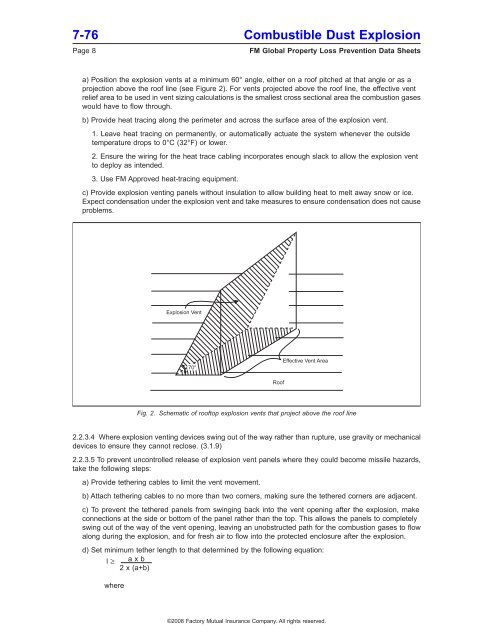DS 7-76 Prevention and Mitigation of Combustible Dust ... - FM Global
DS 7-76 Prevention and Mitigation of Combustible Dust ... - FM Global
DS 7-76 Prevention and Mitigation of Combustible Dust ... - FM Global
You also want an ePaper? Increase the reach of your titles
YUMPU automatically turns print PDFs into web optimized ePapers that Google loves.
7-<strong>76</strong> <strong>Combustible</strong> <strong>Dust</strong> Explosion<br />
Page 8 <strong>FM</strong> <strong>Global</strong> Property Loss <strong>Prevention</strong> Data Sheets<br />
a) Position the explosion vents at a minimum 60° angle, either on a ro<strong>of</strong> pitched at that angle or as a<br />
projection above the ro<strong>of</strong> line (see Figure 2). For vents projected above the ro<strong>of</strong> line, the effective vent<br />
relief area to be used in vent sizing calculations is the smallest cross sectional area the combustion gases<br />
would have to flow through.<br />
b) Provide heat tracing along the perimeter <strong>and</strong> across the surface area <strong>of</strong> the explosion vent.<br />
1. Leave heat tracing on permanently, or automatically actuate the system whenever the outside<br />
temperature drops to 0°C (32°F) or lower.<br />
2. Ensure the wiring for the heat trace cabling incorporates enough slack to allow the explosion vent<br />
to deploy as intended.<br />
3. Use <strong>FM</strong> Approved heat-tracing equipment.<br />
c) Provide explosion venting panels without insulation to allow building heat to melt away snow or ice.<br />
Expect condensation under the explosion vent <strong>and</strong> take measures to ensure condensation does not cause<br />
problems.<br />
2.2.3.4 Where explosion venting devices swing out <strong>of</strong> the way rather than rupture, use gravity or mechanical<br />
devices to ensure they cannot reclose. (3.1.9)<br />
2.2.3.5 To prevent uncontrolled release <strong>of</strong> explosion vent panels where they could become missile hazards,<br />
take the following steps:<br />
a) Provide tethering cables to limit the vent movement.<br />
b) Attach tethering cables to no more than two corners, making sure the tethered corners are adjacent.<br />
c) To prevent the tethered panels from swinging back into the vent opening after the explosion, make<br />
connections at the side or bottom <strong>of</strong> the panel rather than the top. This allows the panels to completely<br />
swing out <strong>of</strong> the way <strong>of</strong> the vent opening, leaving an unobstructed path for the combustion gases to flow<br />
along during the explosion, <strong>and</strong> for fresh air to flow into the protected enclosure after the explosion.<br />
d) Set minimum tether length to that determined by the following equation:<br />
l ≥ a x b<br />
2 x (a+b)<br />
where<br />
Fig. 2. Schematic <strong>of</strong> ro<strong>of</strong>top explosion vents that project above the ro<strong>of</strong> line<br />
©2008 Factory Mutual Insurance Company. All rights reserved.

















